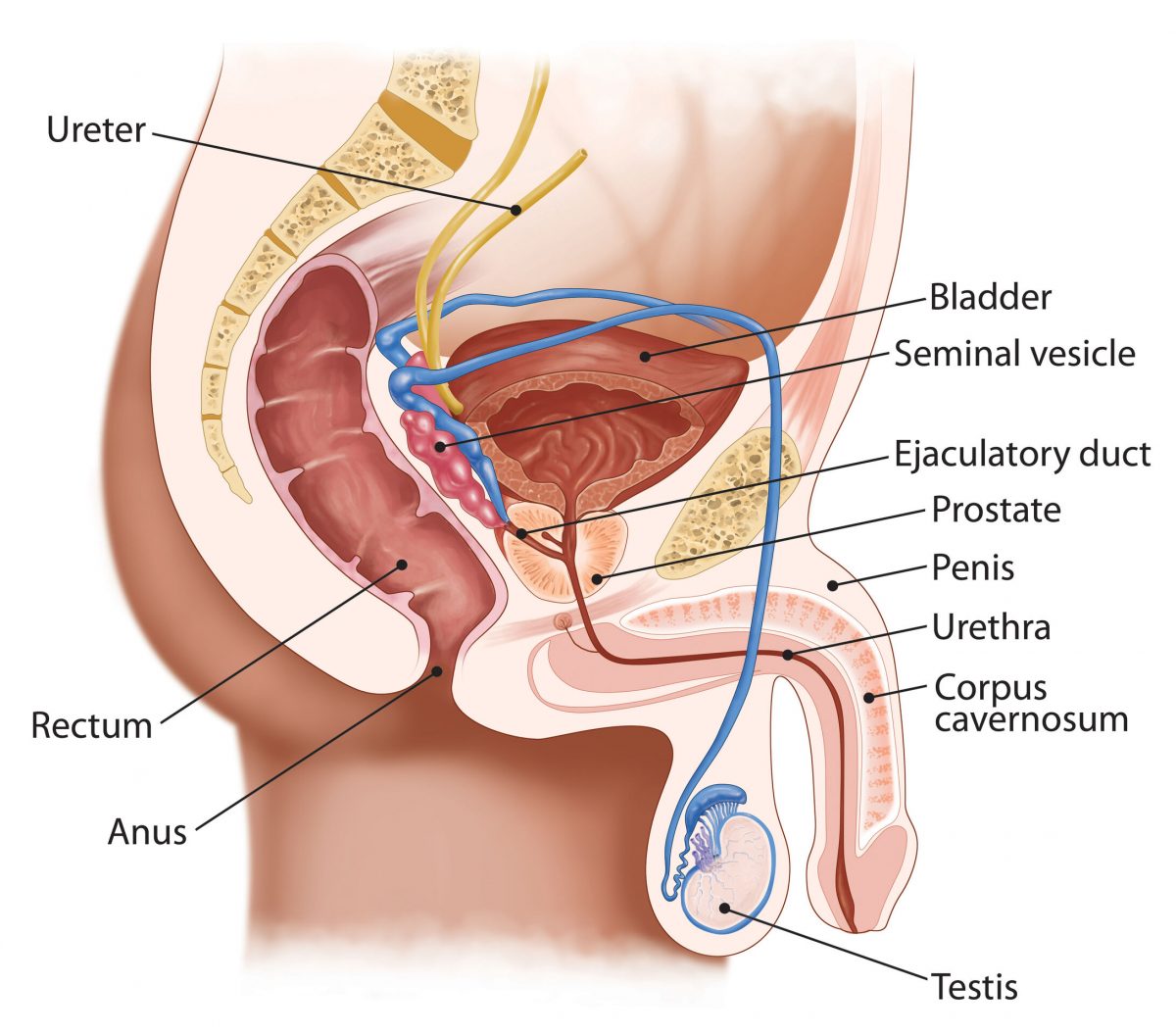
A man’s sex organ (penis) is separate from his internal reproductive anatomy (testes and glands) but also integral. The penis has three main functions.
Firstly men use their penis to urinate (but only when flaccid). Urine and semen both pass down the urethra, the tube which extends through the length of the penis. When a man has an erection, the muscles at the base of the bladder contract and close off the urethra so urine cannot be released.
Secondly the penis is the male sex organ. When a man has an erection, his penis becomes highly sensitised and pleasurable to touch. The erect penis juts out from the body at an angle of approximately 45 degrees. When a man’s mind is focused on erotic stimuli and he massages his erect penis, he can usually orgasm easily. A man feels strong pelvic muscle contractions and highly pleasurable sensations of sexual release both in his mind and body.
Thirdly the penis acts as a reproductive organ. The male reproductive organs include the penis, the testes and various glands (including Cowper’s gland and the prostate). Male orgasm triggers the ejaculation of semen, which contain a man’s spermatozoa (sperm). Intercourse is an activity that facilitates male ejaculation of semen. The sperm (from the testes) pass from the penis (via the vagina) into the uterus to meet the egg (produced by the ovaries). The penis and the vagina act as reproductive conduits during intercourse. When a sperm cell and an egg fuse, a new life is formed.
Many mammals, including most primates, have a penis bone (bacula) that facilitates penetration. Females have an equivalent bone in the clitoris. Humans appear to be unique in having blood flow to the genitals, which in the male is trapped and causes the erection that makes penetration possible.
The post-adolescent penis is designed so that it can become capable of penetration. The penis consists of erectile tissue, connective tissue and skin. It has a shaft, which has a core of erectile tissue, containing a specialized arrangement of arteries within a matrix of connective tissue. Two cylinder-shaped chambers (called corpora cavernosa) run the length of the penis (either side of the central urethra tube). When these spongey chambers fill with blood, the penis becomes rigid and increases in size (both in width and in length). This creates an internal strength and rigidity that is far greater than would be possible if a hollow tube were filled to an equivalent pressure.
The corpora cavernosa are encased in a sheath of tough fibrous connective tissue (Bucks fascia). Between this sheath and the overlying skin is a layer of elastic connective tissue that allows the skin of the penis to move freely along the shaft. The skin, which is slightly darker in colour than the rest of the body, is loose and folded while the penis is in a flaccid state. A circular fold of skin, commonly called the foreskin (or prepuce), extends forward to cover the glans, which is the bulb at the end of the penis. At birth or during early childhood, the foreskin may be removed (this custom is probably due to hygiene issues) in an operation called circumcision. The penis and clitoris extend far back into the pelvis between the muscles of the lower abdomen.
When a man is aroused, his brain sends messages to the nerves in the penis causing the arteries to relax and blood to flow in. The resulting pressure causes the penis to expand, which compresses the veins that normally allow the blood to drain away. Once the blood is trapped, a muscle within the corpora cavernosa sustains the erection. An erection is reversed when the muscles contract and stop blood flowing into the corpora cavernosa. It is common and quite normal for the penis to be curved (sometimes sideways). There is no detrimental effect on either reproduction or on sexual pleasure.
Orgasm is possible without ejaculation. But ejaculation is always preceded by an orgasm. Ejaculation relies on a trigger. There is no physiological event other than orgasm that could trigger ejaculation. The sensations that accompany orgasm vary considerably depending on the physical and psychological (erotic or emotional) circumstances that give rise to orgasm.
Some male prostitutes can climax five, six or more times per day regularly over many years. Even with such high frequencies, although the quantity of ejaculate is lower than usual, a little semen is always produced. Around three quarters of men do not ejaculate with any force. Their semen is merely exuded from the glans. Other men may ejaculate semen over distances of a few inches or even a few feet (very rarely up to even a meter or more!).
Orgasm is a vital aspect of male reproductive function. The pleasure provided by orgasm triggers ejaculation and starts the reproductive process. Achieving penetration and ejaculation are key to men’s sense of emotional well-being. Most men identify with a masculine image that gives them control in sexual scenarios. Men need this control, not only to obtain their sexual release, but also to fulfil their biological imperative to impregnate a female.
A penetrating male attracts a lover by impressing her (or him) with his confidence (his ability to maintain a strong erection and enjoy extended thrusting activity with a lover). This dominant nature is matched by the more passive nature of a receiving partner who has a lower responsiveness. Some heterosexual men worry that enjoying anal penetration is a sign of being submissive, perverted or gay. Men’s inhibition over enjoying anal penetration arises because they associate being a receiver of intercourse with the subordinated role that women naturally assume in heterosexual activity.
The relaxed penis can be any size, depending on ambient temperature. (Antony Mason)
Excerpt from Learn About Sexuality (ISBN 978-0956-894748)















